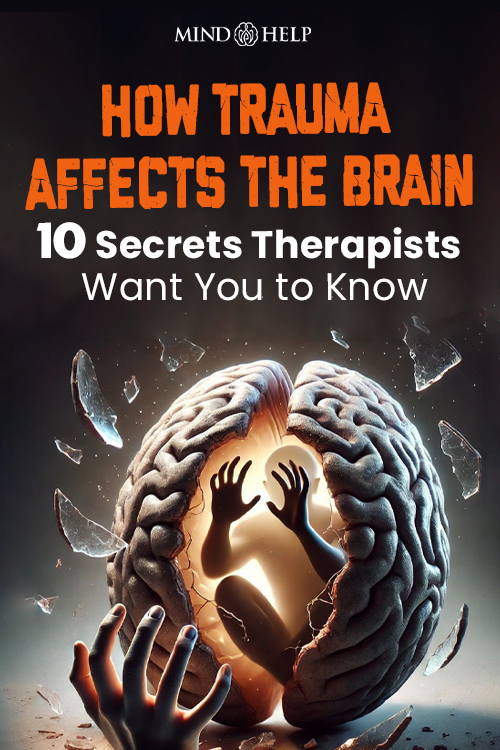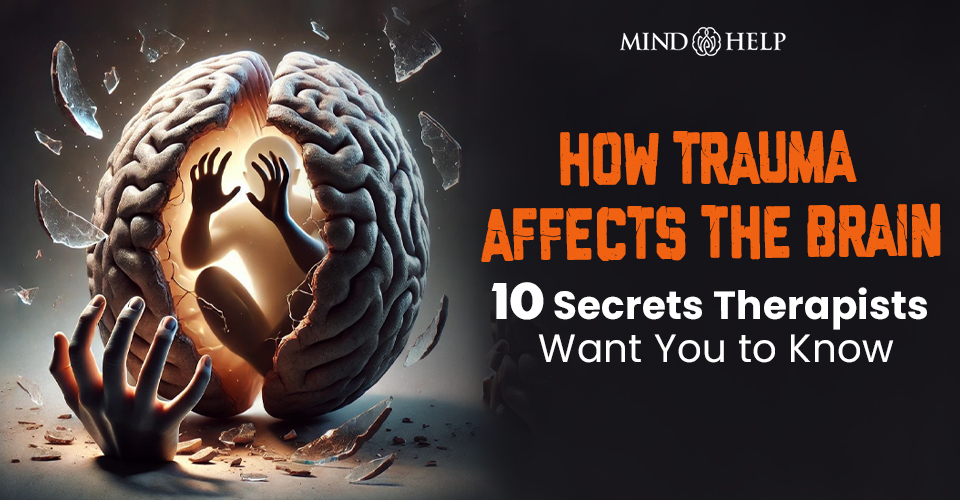How trauma affects the brain is more than just a psychology headline, it’s a full-body experience happening inside your skull.
When you go through something painful or terrifying, it doesn’t just “mess with your emotions”; it actually rewires how your brain works. The effects of trauma on the brain can show up as anxiety, numbness, or overreactions that seem to come out of nowhere.
Understanding what trauma does to the brain reveals why we get stuck in survival mode and how emotional trauma and the brain are deeply connected.
The best part? Brain changes after trauma can be healed and reversed.
Related: How Trauma Affects Our Life: Understanding The 4 Trauma Responses That Run The Show
Trauma Isn’t Just a “Bad Memory” – It’s a Brain Response
When you experience trauma, whether it’s an accident, heartbreak, abuse, or loss – your brain’s emergency system goes into full alert mode.
Instead of processing the event like a normal memory, your brain treats it as a life-or-death situation. Three major brain areas are at play here: the amygdala, the hippocampus, and the prefrontal cortex.
Let’s break down how each one works, explore what trauma does to the brain.
How Trauma Affects The Brain
1. Amygdala: The Brain’s Alarm Syste
Think of the amygdala as your brain’s fire alarm. Its job is to detect danger and trigger your fight, flight, or freeze response. When you go through something traumatic, the amygdala becomes overactive. It starts seeing danger everywhere, even when there isn’t any.
For example:
- A car backfiring might send someone with PTSD straight into panic mode.
- A raised voice could make a domestic violence survivor freeze, even though no one if yelling at them.
This happens because the amygdala can’t tell the difference between a memory and a threat. It reacts as if the trauma is happening again, flooding your body with stress hormones like cortisol and adrenaline.
Over time, this constant activation can make you anxious, hypervigilant, or emotionally reactive. These are classic signs of how trauma affects the brain.
2. Hippocampus: The Memory Keeper
The hippocampus helps store and organize memories, deciding what belongs in the past and what’s relevant now. But trauma disrupts this process.
During a traumatic event, the flood of stress hormones can shrink or suppress the hippocampus, making it hard to put experiences into proper order.
That’s why trauma memories often feel fragmented or timeless, they come in flashes, sensations, or emotions, not as a clear story.
For example:
- A person might vividly recall the smell of smoke from a fire but not remember how they escaped.
- Someone who experienced emotional abuse may not recall specific incidents but still feel an overwhelming sense of danger in certain relationships.
The effects of trauma on the brain are especially visible here, the hippocampus can’t file memories away properly, so the trauma keeps replaying like a loop you can’t stop.
3. Prefrontal Cortex: The Voice of Reason
The prefrontal cortex is the rational, decision-making part of your brain, and it’s responsible for helping you plan, reason, and calm yourself down.
However, when the amygdala is screaming “Danger” and the hippocampus is confused, the prefrontal cortex often shuts down.
That’s why people say and do things under stress they wouldn’t normally do, or why “just calm down” never works for someone triggered by trauma.
For example:
- You might know logically that you are safe, but your body is still reacting as if you are not.
- You might freeze up during an argument, even though part of you knows the situation isn’t life-threatening.
This disconnect between emotion and logic is one of the most common brain changes after trauma. It is your brain protecting you, even if it does not feel helpful in the moment.
Trauma and Brain Function: When the Past Keeps Hijacking the Present
Have you ever wondered why your brain suddenly replays something painful that happened years ago? And just out of nowhere? Well, that’s your trauma memory in action.
The thing is your brain does not understand time when it comes trauma, and it reacts as if it’s still happening.
Something as simple as a smell or sound can trigger that memory network and throw you right back into survival mode.
That’s how trauma and brain function works; the very system that is supposed to protect you can accidentally trap you in old pain.
And that’s why therapy isn’t just “talking about your feelings.” It’s about retraining the brain to know that the danger is over.
Now that we have understood how trauma affects the brain, and the connection between emotional trauma and the brain, let’s talk about what we can do about it.
Related: 10 Powerful Trauma Books By Women You Need To Read
The Effects of Trauma on the Brain Are Reversible (Yes, Really)
Here’s the best part: your brain is resilient. It can heal, rewire, and grow new neural pathways. That’s the beauty of neuroplasticity – your brain’s ability to change and adapt.
Research shows that certain therapies and practices can literally calm the amygdala, repair the hippocampus, and strengthen the prefrontal cortex, restoring emotional balance and safety.
Here are a few proven strategies to if you are dealing with the effects of trauma on the brain:
1. Mindfulness and Meditation
When it comes to emotional trauma and the brain, mindfulness helps activate your prefrontal cortex, the part responsible for logic and calm decision-making. Even 10 minutes a day of focused breathing can lower stress hormones, quiet the amygdala, and remind your brain that it’s safe now.
2. Sound Therapy and Binaural Beats
When you listen to specific sound frequencies, or binaural beats, your brain hemispheres synchronize and work towards relaxing you. Theta waves (6-10 Hz) are especially effective in easing trauma-related hyperarousal before sleep.
3. Weighted Blankets and Deep Pressure Touch
This is one of the underrated but best things you can do when it comes to dealing with the effects of trauma on the brain.
Deep pressure triggers oxytocin release, signaling safety to the brain. Weighted blankets or compression therapy helps a great in reducing anxiety, and helps trauma survivors feel more secure, safe, and grounded.
4. Therapies That Rewire Trauma Responses
- EMDR (Eye Movement Desensitization and Reprocessing): Helps the brain reprocess traumatic memories so they lose their emotional charge.
- Trauma-Focused CBT: Challenges negative beliefs formed by trauma and replaces them with realistic, healing perspectives.
- Somatic Therapy: Focuses on releasing trauma stored in the body by combining mindfulness, breathing, and movement.
Each of these works by reconnecting the emotional and logical parts of the brain, allowing healing from the inside out.
5. Physical Exercise
When you exercise, it releases endorphins, regulates your stress response system, and helps boost your mood. Even a 10-15 minute daily walk can make your mind-body connection stronger, and help your brain release stored tension.
6. . Cold Exposure or Contrast Therapy
As far as emotional trauma and the brain is concerned, cold showers, ice baths, or even splashing your face with cold water activate the vagus nerve, which then calms the nervous system, and also reduces cortisol spikes linked to stress and trauma.
7. Novelty and Playfulness
Trauma thrives on predictability; so when you indulge in some good old play, it sparks neuroplasticity. Laughing, exploring new places, and learning new things activates the dopamine circuits that serve as a reminder that life can be joyful again.
8. Bilateral Movement (Walk, Dance, Drum It Out)
Moving both sides of your body, like when you are walking, dancing, or even tapping to music, helps your brain sync up and process old emotional junk. It tells your amygdala, “We’re safe now.”
Bonus tip: listen to music that bounces between your left and right ear; you will see that it is surprisingly calming.
9. Humming, Chanting, and Vocal Toning
It sounds simple, but humming or chanting can actually calm your nervous system. The vibration in your throat activates your vagus nerve – basically your body’s “off switch” for stress – and helps pull you out of fight-or-flight mode.
10. Eco-Therapy and Nature Immersion
Nature literally changes your brain chemistry. Whether it’s walking barefoot on grass, watering plants, or just sitting under a tree, being outdoors lowers stress hormones and grounds you in the present moment. It’s your brain’s way of remembering: “Right now, I’m okay.”
Related: Healing from Trauma: 5 Myths You Shouldn’t Believe
Takeaway
The effects of trauma on the brain are profound, but the number of ways to heal them is equally vast. From sound therapy and creative expression to cold exposure, humming, and co-regulation, healing isn’t just about the mind, it’s a full-body experience.
Understanding how trauma affects the brain is just the beginning. What comes next is learning that every breath, every safe connection, every new experience teaches your brain the same message:
“The danger is over. You’re safe now.”
And that’s when true recovery begins. Not by forgetting the past, but by understanding the relationship between trauma and brain function, and retraining the brain to finally feel at home in the present.




